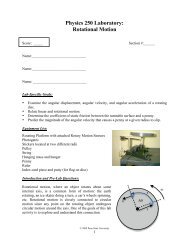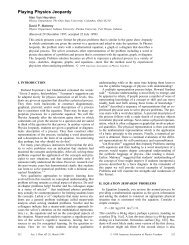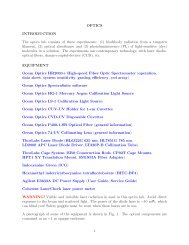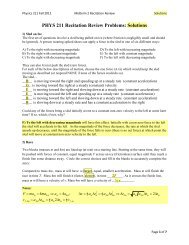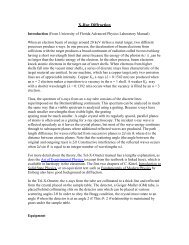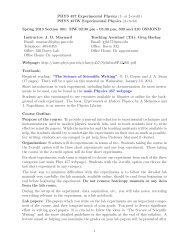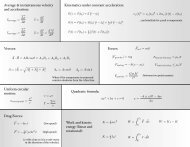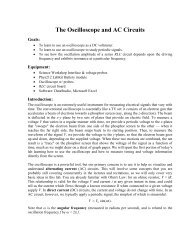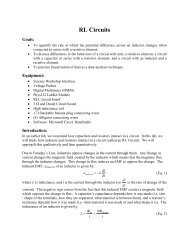Page 1 1) A particle of mass 5 kg is acted on by two forces, F = 3 + 4 ...
Page 1 1) A particle of mass 5 kg is acted on by two forces, F = 3 + 4 ...
Page 1 1) A particle of mass 5 kg is acted on by two forces, F = 3 + 4 ...
Create successful ePaper yourself
Turn your PDF publications into a flip-book with our unique Google optimized e-Paper software.
1) A <str<strong>on</strong>g>particle</str<strong>on</strong>g> <str<strong>on</strong>g>of</str<strong>on</strong>g> <str<strong>on</strong>g>mass</str<strong>on</strong>g> 5 <str<strong>on</strong>g>kg</str<strong>on</strong>g> <str<strong>on</strong>g>is</str<strong>on</strong>g> <str<strong>on</strong>g>acted</str<strong>on</strong>g> <strong>on</strong> <strong>by</strong> <strong>two</strong> <strong>forces</strong>, F ! = 3ı + 4ȷ N and F ! =<br />
−2ı + 1ȷ N and <str<strong>on</strong>g>is</str<strong>on</strong>g> moved from r ! = 1ı + 1ȷ m to r ! = 5ı − 4ȷ m. What <str<strong>on</strong>g>is</str<strong>on</strong>g> the net<br />
work d<strong>on</strong>e <strong>on</strong> the <str<strong>on</strong>g>particle</str<strong>on</strong>g>?<br />
A) -21 J B) -11 J C) -9 J<br />
D) -1 J E) 7 J<br />
2) A 90 <str<strong>on</strong>g>kg</str<strong>on</strong>g> object <str<strong>on</strong>g>is</str<strong>on</strong>g> initially moving in a straight line with a speed <str<strong>on</strong>g>of</str<strong>on</strong>g> 40 m/s. It <str<strong>on</strong>g>is</str<strong>on</strong>g><br />
brought to rest <strong>by</strong> a force providing a c<strong>on</strong>stant decelerati<strong>on</strong>. The work d<strong>on</strong>e <strong>by</strong> the force<br />
<str<strong>on</strong>g>is</str<strong>on</strong>g>:<br />
A) -7.2 × 10 4 J B) -3.6 × 10 3 J C) 1.44 × 105 J<br />
D) 7.2 × 10 4 J E) -1.8 × 10<br />
3 J<br />
<str<strong>on</strong>g>Page</str<strong>on</strong>g> 1
3) A single force acts <strong>on</strong> a body that moves al<strong>on</strong>g a straight line. The figure shown <str<strong>on</strong>g>is</str<strong>on</strong>g> a<br />
plot <str<strong>on</strong>g>of</str<strong>on</strong>g> velocity vs. time for the body. During which time interval <str<strong>on</strong>g>is</str<strong>on</strong>g> the magnitude <str<strong>on</strong>g>of</str<strong>on</strong>g> the<br />
work d<strong>on</strong>e <strong>on</strong> the object largest?<br />
A) AB<br />
B) BC<br />
C) CD<br />
D) DE<br />
E) EF<br />
velocity (m/s)!<br />
4.5!<br />
4!<br />
3.5!<br />
D<br />
3!<br />
F<br />
2.5!<br />
2! B<br />
1.5!<br />
1!<br />
C<br />
0.5!<br />
0!<br />
0! 1! 2! 3! 4! 5! 6!<br />
A<br />
velocity vs. time!<br />
time (s)!<br />
E<br />
4) As the figure below shows, a 4.4 <str<strong>on</strong>g>kg</str<strong>on</strong>g> block <str<strong>on</strong>g>is</str<strong>on</strong>g> accelerated <strong>by</strong> a compressed spring<br />
whose spring c<strong>on</strong>stant <str<strong>on</strong>g>is</str<strong>on</strong>g> 640 N/m. After leaving the spring at the spring's relaxed length,<br />
the block travels over a horiz<strong>on</strong>tal surface, with a coefficient <str<strong>on</strong>g>of</str<strong>on</strong>g> kinetic fricti<strong>on</strong> <str<strong>on</strong>g>of</str<strong>on</strong>g> 0.25,<br />
for a d<str<strong>on</strong>g>is</str<strong>on</strong>g>tance <str<strong>on</strong>g>of</str<strong>on</strong>g> 7.8 m before stopping.<br />
Through what d<str<strong>on</strong>g>is</str<strong>on</strong>g>tance was the spring compressed before the block began to move?<br />
A) 0.131 m B) 0.184 m C) 0.361 m<br />
D) 0.512 m E) Insufficient informati<strong>on</strong> has been provided<br />
<str<strong>on</strong>g>Page</str<strong>on</strong>g> 2
5) A mechanic pushes a 2500 <str<strong>on</strong>g>kg</str<strong>on</strong>g> car from rest to a speed V doing 2500 J <str<strong>on</strong>g>of</str<strong>on</strong>g> work in the<br />
process. During th<str<strong>on</strong>g>is</str<strong>on</strong>g> time the car moves 25 m. Ignoring fricti<strong>on</strong>, the final velocity <str<strong>on</strong>g>of</str<strong>on</strong>g> the<br />
car <str<strong>on</strong>g>is</str<strong>on</strong>g>:<br />
A) 0.040 m/s B) 1.00 m/s C) 1.41 m/s<br />
D) 4.54 m/s E) 100.0 m/s<br />
6) Juliet <str<strong>on</strong>g>is</str<strong>on</strong>g> standing <strong>on</strong> a balc<strong>on</strong>y that <str<strong>on</strong>g>is</str<strong>on</strong>g> 6 m above ground level. What <str<strong>on</strong>g>is</str<strong>on</strong>g> the minimum<br />
speed Romeo, standing <strong>on</strong> the ground, must throw the bouquet <str<strong>on</strong>g>of</str<strong>on</strong>g> flowers to reach Juliet?<br />
(Ignore the effects <str<strong>on</strong>g>of</str<strong>on</strong>g> air res<str<strong>on</strong>g>is</str<strong>on</strong>g>tance.)<br />
A) 8.9 m/s B) 10.8 m/s C) 24.3 m/s<br />
D) 117 m/s E) 150 m/s<br />
<str<strong>on</strong>g>Page</str<strong>on</strong>g> 3
7) The total work required to accelerate a car from 0 to 45 mph:<br />
A) <str<strong>on</strong>g>is</str<strong>on</strong>g> more than that required to accelerate it from 45 to 60 mph.<br />
B) <str<strong>on</strong>g>is</str<strong>on</strong>g> less than that required to accelerate it from 45 to 60 mph.<br />
C) <str<strong>on</strong>g>is</str<strong>on</strong>g> equal to that required to accelerate from 45 to 60 mph.<br />
D) may be any <str<strong>on</strong>g>of</str<strong>on</strong>g> A, B, C depending <strong>on</strong> the time interval and the effect <str<strong>on</strong>g>of</str<strong>on</strong>g> the<br />
accelerati<strong>on</strong>.<br />
E) may be any <str<strong>on</strong>g>of</str<strong>on</strong>g> A, B, C depending <strong>on</strong> the force used to accelerate the car.<br />
8) James B<strong>on</strong>d falls from an airplane without a parachute in pursuit <str<strong>on</strong>g>of</str<strong>on</strong>g> a villain who fell<br />
from the same airplane several sec<strong>on</strong>ds before him (the villain has a parachute but has not<br />
yet deployed it). B<strong>on</strong>d observes that the villain <str<strong>on</strong>g>is</str<strong>on</strong>g> falling at a c<strong>on</strong>stant terminal velocity<br />
(having spread himself out), and decides to plunge down head first to catch up with the<br />
villain and wrest the parachute from him. While B<strong>on</strong>d catches up to the villain, which<br />
Physics 211 c<strong>on</strong>clusi<strong>on</strong> could he correctly infer?<br />
A) The net force <strong>on</strong> the villain <str<strong>on</strong>g>is</str<strong>on</strong>g> the villain’s weight.<br />
B) The work d<strong>on</strong>e <strong>by</strong> air res<str<strong>on</strong>g>is</str<strong>on</strong>g>tance <strong>on</strong> the villain <str<strong>on</strong>g>is</str<strong>on</strong>g> negligible compared to that d<strong>on</strong>e <strong>by</strong><br />
gravity.<br />
C) The mechanical energy K+U grav <str<strong>on</strong>g>of</str<strong>on</strong>g> the villain <str<strong>on</strong>g>is</str<strong>on</strong>g> c<strong>on</strong>served during the villain’s fall.<br />
D) The terminal velocity <str<strong>on</strong>g>of</str<strong>on</strong>g> the villain would be twice as large if he were half as heavy.<br />
E) There <str<strong>on</strong>g>is</str<strong>on</strong>g> no net work d<strong>on</strong>e <strong>on</strong> the villain.<br />
<str<strong>on</strong>g>Page</str<strong>on</strong>g> 4
9) A 9 <str<strong>on</strong>g>kg</str<strong>on</strong>g> <str<strong>on</strong>g>mass</str<strong>on</strong>g> moves al<strong>on</strong>g the x ax<str<strong>on</strong>g>is</str<strong>on</strong>g>. Its accelerati<strong>on</strong> as a functi<strong>on</strong> <str<strong>on</strong>g>of</str<strong>on</strong>g> its positi<strong>on</strong> <str<strong>on</strong>g>is</str<strong>on</strong>g><br />
shown in the figure below. What <str<strong>on</strong>g>is</str<strong>on</strong>g> the net work performed <strong>on</strong> the <str<strong>on</strong>g>mass</str<strong>on</strong>g> <strong>by</strong> the force<br />
causing the accelerati<strong>on</strong> as the <str<strong>on</strong>g>mass</str<strong>on</strong>g> moves from x = 0 to x = 8.0 m?<br />
A) 80 J B) 160 J C) 353 J<br />
D) 720 J E) 1440 J<br />
10) A 1 <str<strong>on</strong>g>kg</str<strong>on</strong>g> ball <str<strong>on</strong>g>is</str<strong>on</strong>g> loaded into a spring gun with a spring c<strong>on</strong>stant <str<strong>on</strong>g>of</str<strong>on</strong>g> 10 5 N/m. If the<br />
spring <str<strong>on</strong>g>is</str<strong>on</strong>g> compressed <strong>by</strong> 0.1 m and the ball <str<strong>on</strong>g>is</str<strong>on</strong>g> shot up vertically, how high does it r<str<strong>on</strong>g>is</str<strong>on</strong>g>e into<br />
the air?<br />
A) 12.7 cm B) 1.3 m C) 12.7 m<br />
D) 102.0 m E) 51.0 m<br />
<str<strong>on</strong>g>Page</str<strong>on</strong>g> 5
11) A 1000 <str<strong>on</strong>g>kg</str<strong>on</strong>g> block <str<strong>on</strong>g>of</str<strong>on</strong>g> granite <str<strong>on</strong>g>is</str<strong>on</strong>g> pulled up an incline 30 m high and 40 m in horiz<strong>on</strong>tal<br />
length at a c<strong>on</strong>stant speed <str<strong>on</strong>g>of</str<strong>on</strong>g> 2 m/s <strong>by</strong> a cable and winch. The coefficient <str<strong>on</strong>g>of</str<strong>on</strong>g> kinetic<br />
fricti<strong>on</strong> between the block and the incline <str<strong>on</strong>g>is</str<strong>on</strong>g> µ k = 0.4. What <str<strong>on</strong>g>is</str<strong>on</strong>g> the power due to the<br />
tensi<strong>on</strong> force in the cable?<br />
A) 20384 W<br />
B) 24131 W<br />
C) 9016 W<br />
D) 6112 W<br />
E) 18032 W<br />
12) A small, 0.1 <str<strong>on</strong>g>kg</str<strong>on</strong>g> rubber ball <str<strong>on</strong>g>is</str<strong>on</strong>g> dropped at rest from a height <str<strong>on</strong>g>of</str<strong>on</strong>g> 3 m, bounces <str<strong>on</strong>g>of</str<strong>on</strong>g>f the<br />
floor and rebounds to a height <str<strong>on</strong>g>of</str<strong>on</strong>g> 2.5 m. What <str<strong>on</strong>g>is</str<strong>on</strong>g> the magnitude <str<strong>on</strong>g>of</str<strong>on</strong>g> the impulse <str<strong>on</strong>g>of</str<strong>on</strong>g> the floor<br />
acting <strong>on</strong> the ball? (Hint: find the velocity <str<strong>on</strong>g>of</str<strong>on</strong>g> the ball just before and just after the<br />
coll<str<strong>on</strong>g>is</str<strong>on</strong>g>i<strong>on</strong> with the floor, and c<strong>on</strong>sider the directi<strong>on</strong> <str<strong>on</strong>g>of</str<strong>on</strong>g> each velocity.)<br />
A) 0.067 <str<strong>on</strong>g>kg</str<strong>on</strong>g> m/s B) 0.49 <str<strong>on</strong>g>kg</str<strong>on</strong>g> m/s C) 0 <str<strong>on</strong>g>kg</str<strong>on</strong>g> m/s<br />
D) 1.47 <str<strong>on</strong>g>kg</str<strong>on</strong>g> m/s E) Impossible to determine since the coll<str<strong>on</strong>g>is</str<strong>on</strong>g>i<strong>on</strong> <str<strong>on</strong>g>is</str<strong>on</strong>g> inelastic.<br />
<str<strong>on</strong>g>Page</str<strong>on</strong>g> 6
13) A c<strong>on</strong>servative force F(x) acts <strong>on</strong> a 2.0 <str<strong>on</strong>g>kg</str<strong>on</strong>g> <str<strong>on</strong>g>particle</str<strong>on</strong>g> that moves al<strong>on</strong>g the x-ax<str<strong>on</strong>g>is</str<strong>on</strong>g>. The<br />
potential energy U(x) associated with F(x) <str<strong>on</strong>g>is</str<strong>on</strong>g> shown in the figure below. When the<br />
<str<strong>on</strong>g>particle</str<strong>on</strong>g> <str<strong>on</strong>g>is</str<strong>on</strong>g> at x=10.0 m, its velocity <str<strong>on</strong>g>is</str<strong>on</strong>g> 3.16 m/s. Between what limits <str<strong>on</strong>g>of</str<strong>on</strong>g> x does the <str<strong>on</strong>g>particle</str<strong>on</strong>g><br />
move?<br />
U(x) (J)<br />
5<br />
0<br />
-5<br />
-10<br />
-15<br />
-20<br />
-25<br />
0 5 10 15 20<br />
x (m)<br />
A) x min = −∞, x max = +∞ B) x min = 0 m, x max = 20 m<br />
C) x min = 5 m, x max = 15 m D) x min = 7.5 m, x max = 12.5 m<br />
E) The <str<strong>on</strong>g>particle</str<strong>on</strong>g> remains at x min = x max = 10 m<br />
14) A 4 <str<strong>on</strong>g>kg</str<strong>on</strong>g> <str<strong>on</strong>g>mass</str<strong>on</strong>g> moving at +6 m/s undergoes a <strong>on</strong>e-dimensi<strong>on</strong>al elastic coll<str<strong>on</strong>g>is</str<strong>on</strong>g>i<strong>on</strong> with<br />
another 1 <str<strong>on</strong>g>kg</str<strong>on</strong>g> <str<strong>on</strong>g>mass</str<strong>on</strong>g> moving at −4 m/s (in the directi<strong>on</strong> opposite to that <str<strong>on</strong>g>of</str<strong>on</strong>g> the greater <str<strong>on</strong>g>mass</str<strong>on</strong>g>).<br />
What <str<strong>on</strong>g>is</str<strong>on</strong>g> the magnitude <str<strong>on</strong>g>of</str<strong>on</strong>g> the change in momentum <str<strong>on</strong>g>of</str<strong>on</strong>g> the 4 <str<strong>on</strong>g>kg</str<strong>on</strong>g> <str<strong>on</strong>g>mass</str<strong>on</strong>g> as a result <str<strong>on</strong>g>of</str<strong>on</strong>g> th<str<strong>on</strong>g>is</str<strong>on</strong>g><br />
coll<str<strong>on</strong>g>is</str<strong>on</strong>g>i<strong>on</strong>?<br />
A) 32 <str<strong>on</strong>g>kg</str<strong>on</strong>g> m/s B) 16 <str<strong>on</strong>g>kg</str<strong>on</strong>g> m/s C) 8 <str<strong>on</strong>g>kg</str<strong>on</strong>g> m/s<br />
D) 4 <str<strong>on</strong>g>kg</str<strong>on</strong>g> m/s E) 2 <str<strong>on</strong>g>kg</str<strong>on</strong>g> m/s<br />
<str<strong>on</strong>g>Page</str<strong>on</strong>g> 7
15) A car travels around a circular unbanked curve at the maximum speed without<br />
skidding <str<strong>on</strong>g>of</str<strong>on</strong>g>f the road. Which <str<strong>on</strong>g>of</str<strong>on</strong>g> the following statements, if any, <str<strong>on</strong>g>is</str<strong>on</strong>g> false?<br />
A) The centripetal accelerati<strong>on</strong> <str<strong>on</strong>g>is</str<strong>on</strong>g> provided <strong>by</strong> the fricti<strong>on</strong> between the tires and the road.<br />
B) There <str<strong>on</strong>g>is</str<strong>on</strong>g> no work d<strong>on</strong>e <strong>by</strong> the radial comp<strong>on</strong>ent <str<strong>on</strong>g>of</str<strong>on</strong>g> the fricti<strong>on</strong> force between the tires<br />
and the road during the turn.<br />
C) The radial comp<strong>on</strong>ent <str<strong>on</strong>g>of</str<strong>on</strong>g> the force <str<strong>on</strong>g>of</str<strong>on</strong>g> fricti<strong>on</strong> between the tires and the road during the<br />
turn <str<strong>on</strong>g>is</str<strong>on</strong>g> the weight <str<strong>on</strong>g>of</str<strong>on</strong>g> the car multiplied <strong>by</strong> the coefficient <str<strong>on</strong>g>of</str<strong>on</strong>g> static fricti<strong>on</strong> between the<br />
tires and the road.<br />
D) During the turn, the directi<strong>on</strong> <str<strong>on</strong>g>of</str<strong>on</strong>g> the car’s accelerati<strong>on</strong> vector changes with time.<br />
E) All <str<strong>on</strong>g>of</str<strong>on</strong>g> these statements are true.<br />
16) Which <str<strong>on</strong>g>of</str<strong>on</strong>g> the following graphs <str<strong>on</strong>g>of</str<strong>on</strong>g> the kinetic energy as a functi<strong>on</strong> <str<strong>on</strong>g>of</str<strong>on</strong>g> time <str<strong>on</strong>g>is</str<strong>on</strong>g><br />
physically impossible?<br />
A) K<br />
B)<br />
K<br />
0<br />
t<br />
0<br />
t<br />
C) K<br />
D)<br />
K<br />
0<br />
t<br />
0<br />
t<br />
E) All <str<strong>on</strong>g>of</str<strong>on</strong>g> the above are possible<br />
<str<strong>on</strong>g>Page</str<strong>on</strong>g> 8
17) An old Chrysler with <str<strong>on</strong>g>mass</str<strong>on</strong>g> 3000 <str<strong>on</strong>g>kg</str<strong>on</strong>g> <str<strong>on</strong>g>is</str<strong>on</strong>g> moving al<strong>on</strong>g a stretch <str<strong>on</strong>g>of</str<strong>on</strong>g> road at 72 km/h. It <str<strong>on</strong>g>is</str<strong>on</strong>g><br />
followed <strong>by</strong> a Ford with <str<strong>on</strong>g>mass</str<strong>on</strong>g> 2000 <str<strong>on</strong>g>kg</str<strong>on</strong>g> moving at 90 km/h. How fast <str<strong>on</strong>g>is</str<strong>on</strong>g> the center <str<strong>on</strong>g>of</str<strong>on</strong>g> <str<strong>on</strong>g>mass</str<strong>on</strong>g><br />
<str<strong>on</strong>g>of</str<strong>on</strong>g> the <strong>two</strong> cars moving?<br />
A) 81.5 km/h B) 90.0 km/h C) 79.2 km/h<br />
D) 72.0 km/h E) 7.2 km/h<br />
18) A 4000 <str<strong>on</strong>g>kg</str<strong>on</strong>g> truck <str<strong>on</strong>g>is</str<strong>on</strong>g> at rest at an intersecti<strong>on</strong>, waiting for a green light (with no other<br />
vehicles around). It <str<strong>on</strong>g>is</str<strong>on</strong>g> a snowy and icy day, with no fricti<strong>on</strong> <strong>on</strong> the road. A 1000 <str<strong>on</strong>g>kg</str<strong>on</strong>g> car<br />
traveling at 5 m/s strikes the stopped truck square <strong>on</strong> from behind. The bumpers <str<strong>on</strong>g>of</str<strong>on</strong>g> the<br />
<strong>two</strong> vehicles lock together as a result <str<strong>on</strong>g>of</str<strong>on</strong>g> the coll<str<strong>on</strong>g>is</str<strong>on</strong>g>i<strong>on</strong>, so that they skid across the<br />
intersecti<strong>on</strong> together. How fast are they traveling?<br />
A) 1.0 m/s B) 5.0 m/s C) 0 m/s<br />
D) 2.5 m/s E) Impossible to tell since the coll<str<strong>on</strong>g>is</str<strong>on</strong>g>i<strong>on</strong> <str<strong>on</strong>g>is</str<strong>on</strong>g> not elastic<br />
<str<strong>on</strong>g>Page</str<strong>on</strong>g> 9
19) The Earth has a <str<strong>on</strong>g>mass</str<strong>on</strong>g> <str<strong>on</strong>g>of</str<strong>on</strong>g> 5.98×10 24 <str<strong>on</strong>g>kg</str<strong>on</strong>g> and travels around the Sun <strong>on</strong>ce a year (365.25<br />
days) in a roughly circular orbit <str<strong>on</strong>g>of</str<strong>on</strong>g> radius 1.49×10 11 m. How much kinetic energy does<br />
the Earth have?<br />
A) 1.77×10 29 J B) 2.63×10 33 J C) 5.86×10 25 J<br />
D) 6.67×10 43 J E) 3.14×10 51 J<br />
20) An object has an initial (t = 0s) momentum <str<strong>on</strong>g>of</str<strong>on</strong>g> 20 <str<strong>on</strong>g>kg</str<strong>on</strong>g> m/s. It moves under the<br />
influence <str<strong>on</strong>g>of</str<strong>on</strong>g> a force varying with time as per the plot below. What <str<strong>on</strong>g>is</str<strong>on</strong>g> the object’s<br />
momentum at t = 8s ?<br />
10<br />
5<br />
F (N)<br />
0<br />
-5<br />
-10<br />
0 2 4 6 8<br />
t (s)<br />
A) 50 <str<strong>on</strong>g>kg</str<strong>on</strong>g> m/s B) 35 <str<strong>on</strong>g>kg</str<strong>on</strong>g> m/s C) 20 <str<strong>on</strong>g>kg</str<strong>on</strong>g> m/s<br />
D) 0 <str<strong>on</strong>g>kg</str<strong>on</strong>g> m/s E) -10 <str<strong>on</strong>g>kg</str<strong>on</strong>g> m/s<br />
<str<strong>on</strong>g>Page</str<strong>on</strong>g> 10
Answer key<br />
1) A<br />
2) A<br />
3) C<br />
4) D<br />
5) C<br />
6) B<br />
7) A<br />
8) E<br />
9) D<br />
10) E<br />
11) E<br />
12) D<br />
13) D<br />
14) B<br />
15) E<br />
16) C<br />
17) C<br />
18) A<br />
19) B<br />
20) C<br />
<str<strong>on</strong>g>Page</str<strong>on</strong>g> 11




